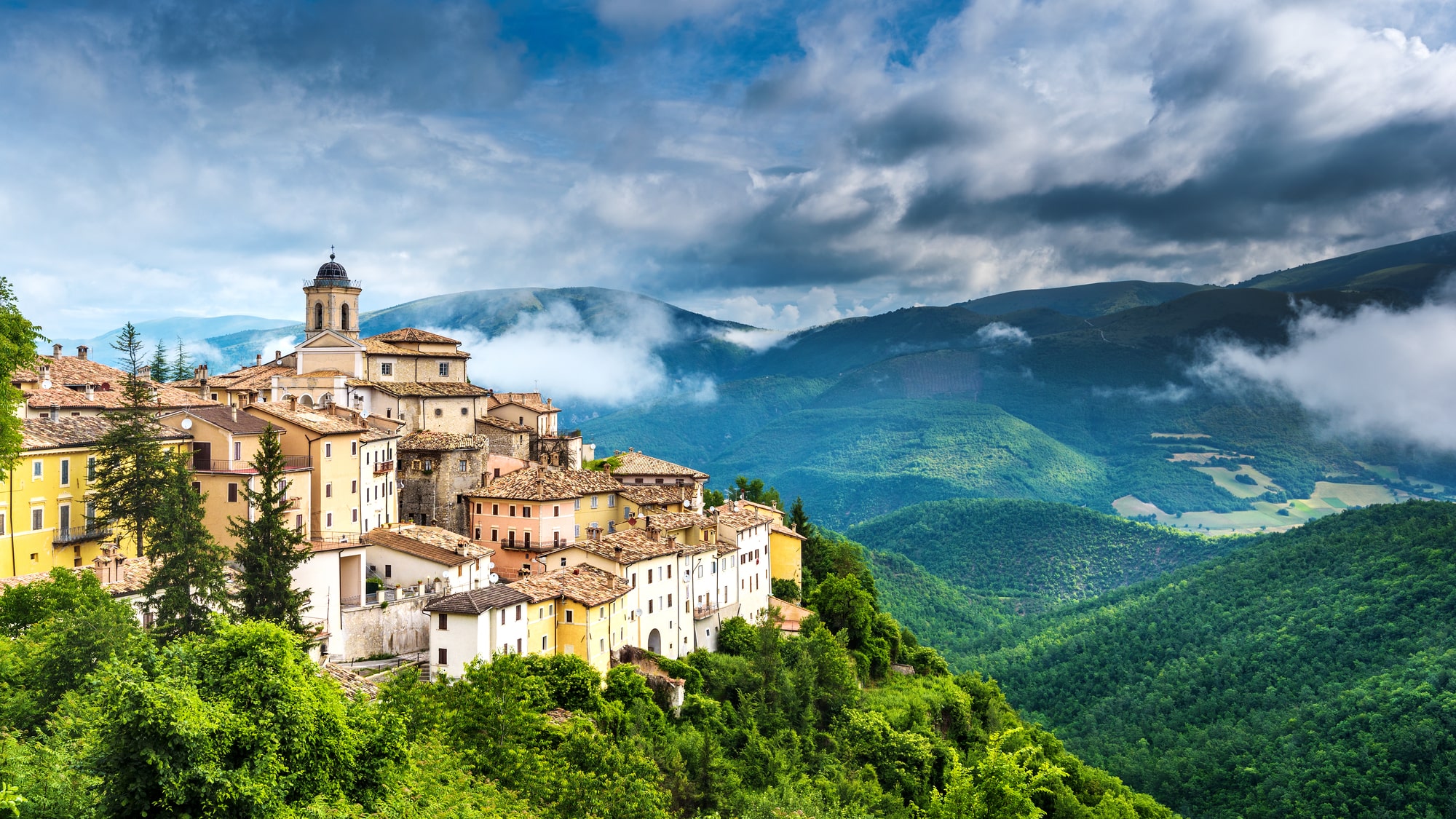A weekend in Umbria: 10 unmissable places to visit
The only region of central Italy not to be bathed by the sea, Umbria is a jewel that makes up for the lack of salt water with the landscapes and medieval villages that cross it. Famous for jazz (here every year there is the Umbria Jazz Festival), the production of chocolate, specialties such as truffles and game and the natural wealth that, among lakes, olive trees and vineyards, gifts it with of the most important food and wine traditions of the country. But what are the places to visit during a weekend in Umbria?
Perugia
Perugia is the capital of Umbria, a town known especially for the production of chocolate (just around Perugia, in San Sisto, was born the Bacio Perugina, the famous chocolate with the heart of hazelnut), its medieval old town and its lively university life. The city has Etruscan origins, but it is during the Middle Ages that it takes shape, collecting the Etruscan and Roman architectural heritage and merging it with new medieval monuments in the appearance that it will retain over the centuries: these are also the years of the birth of its University, one of the oldest and most respected on the continent, which still attracts students from all over the world.
The nerve center of Perugia is Piazza IV Novembre, the former Roman forum in which converge 4 streets called “Vie Regali”: the square houses the Cathedral and the Palazzo Comunale, and in its center stands the Fontana Maggiore, a majestic work of Nicola and Giovanni Pisano. Other monuments of Perugia are Palazzo dei Priori, reachable directly from the square, the Roman Aqueduct (walkable), the Rocca Paolina and the Etruscan Well.
You can’t then visit Perugia without having tasted the local specialties: the city, as well as the entire region, is known for the presence of black and white truffle, for pasta – the strangozzi –, the typical focaccia, the so-called torta al testo, and the cooked pigeon "alla ghiotta", with a sauce based on aromas and raw ham.
 Assisi
Assisi
Universally, the fame of the Umbrian village of Assisi is linked to its most famous citizen: St. Francis. Dedicated to him is the City Cathedral (in whose crypt is the tomb of the Saint), an architectural masterpiece that houses among its naves works by Cimabue, Giotto and Pietro Lorenzetti, but the influence of the Saint also extends to the Franciscan movement and its message of peace and tolerance, which pervade the village and its surroundings.
The city is also linked to the presence of another saint: Santa Chiara, to whom the other main church of Assisi is dedicated. Since 2000, the historic center of the village is a UNESCO World Heritage Site.
Spoleto
Not far from Perugia, along the Via Flaminia, there is another Umbrian village with an evocative atmosphere. Spoleto develops on the Sant'Elia hill, connected to the adjacent village of Montelucco by an aqueduct bridge, and is a Roman town that, over time, has been a pilgrimage destination for many famous people, from Goethe to Carducci. Among its streets you can breathe an air of tradition, of a time that seems to have stopped. Surrounded by greenery, among the key monuments of Spoleto stands the sixteenth-century Rocca Albornoziana, which stands proudly on the hill overlooking the valley.
Even here, you can’t leave the city without having tasted its typical dishes: the omelette with truffles, the soup of San Nicola and the lamb “alla cacciatora” (after all, Umbria loves game).
Gubbio
Also known as "the city of stone" or "the gray city", Gubbio is another medieval village of the Umbrian territory, famous for the processing of majolica. The jewel of the city is Piazza Grande, a sort of hanging square overlooking the valley, but also worth a visit are the Basilica of San Francesco, the Loggia dei Tiratori and the Renaissance Palazzo Ducale. The city also reveals treasures in its surroundings: not far away are in fact the Bottaccione Gorge, an ancient gorge formed following the erosion of the Carmignano stream and its aqueduct, and the Basilica dedicated to Saint Ubaldo, patron saint of the city, on top of Mount Igino.
Spello
Spello is located at the foot of Mount Subasio, not far from Assisi, Spoleto and Perugia. Its fame is linked to olive trees, to the archaic beauty of its historic center, but especially to the flowers. Not for nothing, the city is also nicknamed the "city of flowers": every year, during the procession of Corpus Christi, Spello is filled with carpets and floral paintings, the so-called “infiorate”, works of art that give a fragrant and colorful atmosphere to the village. The walls, the Tega Chapel and the imperial Villa dei Mosaici are also worth a visit.
Trevi
Also Trevi, between Foligno and Spoleto, belongs to the circuit of the most beautiful villages in Italy. It’s also known as the "village of the olive trees" thanks to the production of a variety of very valuable oil, and its medieval center is characterized by the massive presence of pink buildings. Immersed in the green of the olive trees and the valley, it’s one of the most fascinating places in Umbria.
Todi
Called the "city of archers", Todi is an authentic town of Umbria, whose nerve center is undoubtedly Piazza del Popolo, overlooking the eponymous palace, one of the oldest in the entire region. Other notable monuments are Palazzo dei Priori and the Romanesque masterpiece of the Annunziata Cathedral, preceded by a monumental staircase. Todi also overlooks the Umbrian valleys, and from the bell tower of the Cathedral you can enjoy a breathtaking view of the Tiber valley and even see the city of Perugia, 60 km away, in the distance.
The Trasimeno lake
Lake Trasimeno is the largest in central Italy. Admired even by Lord Byron and famous for its artisanal production of copper, iron and lace, it’s surrounded by lush nature and charming villages: between Castiglione del Lago, Città della Pieve, Passignano and Panicale, one is spoiled for choice. The lake also has three islands, among which the most important is the Isola Maggiore, a district of the town of Tuoro still inhabited. The lake cuisine abandons the Umbrian love for game and prefers fish such as eel and perch, but other specialties include the oil of the Trasimeno hills, DOC wines and the Torciglione dessert.
 Orvieto
Orvieto
Orvieto is a town in the province of Terni that rises on an imposing tuff massif, which today can be visited inside thanks to the route of the underground city and the visit to the Etruscan necropolis. Among its famous monuments, the Pozzo di San Patrizio (more than 60 meters deep), the Albornoz Fortress and the Church of San Giovenale, but the highest artistic expression of the village is found in the Cathedral dedicated to Santa Maria Assunta, an architectural masterpiece among the most beautiful in Italy and the world that dominates the city from above with its mosaics and gothic spires.
The waterfall of the Marmore
In the province of Terni there is an artificial waterfall that dates back to 200 BC, when the Romans designed it to drain the waters of the river Velino that flooded the land and transformed large areas into swamps. With a drop of over 160 meters, it is the highest artificial waterfall in Europe and among the highest in the world. The vegetation that surrounds it is a triumph of lush biodiversity, and the rock of which it consists, the travertine, is a very friable material that gave rise to caves and cavities, among which the most famous are the Grotta della Morta and that of the Diaclasi. Over the centuries, the spectacle of the Marmore Falls has enchanted illustrious visitors, from Galileo Galilei to William Turner, making it, in 1800, an unmissable destination of the famous European Grand Tour.
Do you want to discover the best of Italy? Best Italy Tour organizes group tours, private tours, packages, guided tours and cultural tours through the main Italian attractions. What will be your destination? Let’s find it together!



